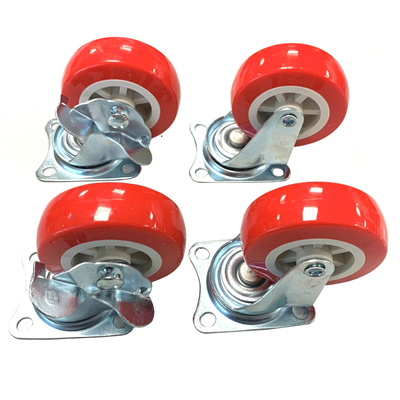Rigid casters are commonly used in industrial settings due to their stability, load-bearing capacity, and precision control. They play a crucial role in facilitating various operations and ensuring safety in industrial environments. Here are some specific applications of rigid casters in industrial settings:
- Material Handling Carts: Rigid casters are frequently used on material handling carts and trolleys in manufacturing facilities. These casters provide stability, allowing workers to transport materials, tools, and finished products safely and efficiently.
- Assembly Line Equipment: Industrial assembly lines often use rigid casters on machinery and workstations. These casters maintain precise alignment and control during the assembly process, ensuring quality and consistency.
- Heavy Machinery: Rigid casters are employed in various heavy machinery applications, including metalworking equipment, CNC machines, and large industrial lathes. They provide stability and controlled movement, especially when working with precision parts.
- Conveyor Systems: Conveyor systems in manufacturing plants use rigid casters to maintain a straight-line path for moving products along the production line. Rigid casters ensure that items stay on course during sorting, packaging, and inspection.
- Automated Guided Vehicles (AGVs): AGVs are used in manufacturing and distribution facilities to transport materials autonomously. Some AGVs are equipped with rigid casters to maintain a fixed orientation and prevent swiveling during transportation.
- Pallet Jacks: Industrial pallet jacks rely on rigid casters to support the weight of heavy pallets while providing control and stability when moving loads.
- Industrial Carts: Industrial carts used for transporting heavy materials or products within a factory or warehouse often incorporate rigid casters to ensure precise and stable movement.
- Foundries and Heavy-Duty Environments: Rigid casters made of robust materials like cast iron or steel are used in foundries and other heavy-duty industrial applications. They can withstand extreme temperatures, heavy loads, and harsh environments.
- Tool Cabinets and Workstations: Tool cabinets and workstations in industrial settings use rigid casters to provide mobility while ensuring that tools and equipment stay securely in place during use.
- Maintenance and Repair Equipment: Carts and equipment used for maintenance, repair, and equipment servicing often use rigid casters for stability, allowing technicians to transport tools and parts with ease.
- Equipment for Hazardous Materials: In settings where hazardous materials are handled, rigid casters are chosen for their stability and controlled movement. They can help prevent accidents and spills.
- Food Processing and Pharmaceuticals: In industries such as food processing and pharmaceuticals, where cleanliness and precision are paramount, rigid casters maintain stability during production and packaging processes.
- Automotive and Aerospace Manufacturing: Industrial equipment used in automotive and aerospace manufacturing, such as jigs and fixtures, may incorporate rigid casters for precision alignment and stability.
- Welding and Fabrication: Welding carts and equipment in metal fabrication shops use rigid casters to ensure stability while moving workpieces and welding equipment.
The use of rigid casters in industrial settings is diverse and essential for optimizing operations, ensuring the safe movement of equipment and materials, and maintaining consistent quality and efficiency in manufacturing and other industrial processes. Proper selection, maintenance, and care of rigid casters are crucial to their reliable performance in these demanding environments


